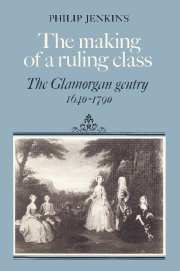Book contents
- Front matter
- Contents
- List of maps and tables
- Acknowledgments
- Abbreviations
- General introduction
- PART I SOCIAL AND ECONOMIC STRUCTURE
- PART II LOCAL AND NATIONAL POLITICS
- Introduction
- 4 Law and order
- 5 Political history 1640 – 1688: the heroic age
- 6 Political history 1688 – 1790: the new order
- Conclusion to Part II
- PART III SOCIETY AND CULTURE
- Conclusion to Part III: ‘conspicuous antiquity’
- Aftermath: towards the Victorian world
- Conclusion: from Civil War to Industrial Revolution
- Appendix 1 Parliamentary service by Glamorgan landowners 1640 – 1800
- Appendix 2 The ‘secondary’ gentry families
- Appendix 3 The ‘tertiary’ families
- Appendix 4 The Mansell family and their connections with the greater gentry
- Appendix 5 The roundhead and puritan family links of the Thomases of Wenvoe
- Notes
- Index
- Front matter
- Contents
- List of maps and tables
- Acknowledgments
- Abbreviations
- General introduction
- PART I SOCIAL AND ECONOMIC STRUCTURE
- PART II LOCAL AND NATIONAL POLITICS
- Introduction
- 4 Law and order
- 5 Political history 1640 – 1688: the heroic age
- 6 Political history 1688 – 1790: the new order
- Conclusion to Part II
- PART III SOCIETY AND CULTURE
- Conclusion to Part III: ‘conspicuous antiquity’
- Aftermath: towards the Victorian world
- Conclusion: from Civil War to Industrial Revolution
- Appendix 1 Parliamentary service by Glamorgan landowners 1640 – 1800
- Appendix 2 The ‘secondary’ gentry families
- Appendix 3 The ‘tertiary’ families
- Appendix 4 The Mansell family and their connections with the greater gentry
- Appendix 5 The roundhead and puritan family links of the Thomases of Wenvoe
- Notes
- Index
Summary
I have frequently had cause to stress the lack of continuity between the history of the gentry community before and after about 1720, so that for once a rough division of a period into centuries is not merely a matter of convenience. Glamorgan was a very different society in the seventeenth century from what it was to become in the eighteenth. It was ruled by a differently composed political elite, and traditional aristocratic power declined greatly by the early Georgian period. After 1700 too, industry became a much greater concern of the landed families, so that we enter a world of more economic and commercial sophistication. This might be symbolised by the transformation of the markets and sources of raw materials on which local industry depended, from a western European to an Atlantic scale.
In political affairs also, a major change took place in the nature and intensity of issues and the composition of factions. This too occurred between the 1690s and 1720s, and it will be suggested how closely this change reflected the social background – particularly demographic changes and the decline of aristocratic dominance. The scale of the change was immense. The political rhetoric of 1740 was very similar to that of 1640 or 1680, but this apparent continuity was an illusion.
Information
- Type
- Chapter
- Information
- The Making of a Ruling ClassThe Glamorgan Gentry 1640–1790, pp. 75 - 77Publisher: Cambridge University PressPrint publication year: 1983
